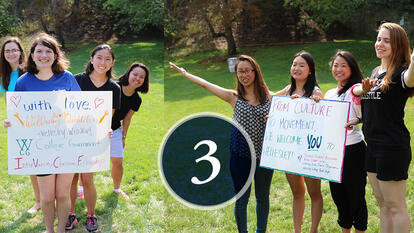Wellesley Student Illustrates Campus Wildlife in Hand-Painted Map

While sketching birds near the boardwalk at Lake Waban one recent morning, Anya Sheldon ’20, a summer intern with the Paulson Ecology of Place Initiative, looked up from her sketchpad and spotted a bald eagle flying in large circles above Wellesley’s campus. Later, on a walk around the lake, she saw a river otter gliding on its back through the water.
Sheldon, a studio art major and environmental studies minor, added both creatures to the colorful hand-painted campus map she was making for the Paulson Initiative, called “Fantastical Creatures of Wellesley College.”
“I’ve been interested in mapping as a way to explore the intersection between art and science,” said Sheldon, who also came across a heron, an owl, a snake, and a giant spider the day she saw the eagle. “I study both disciplines, and they bring out interesting ideas in each other. For this project, I wanted to flavor ecological information about campus with whimsicality and humor. Familiarity with the creatures that share your space is inspiring, and the broadened understanding of your interconnectedness is emotionally healthy, I think, and likely to encourage environmental stewardship.”
She has illustrated the map with 42 animals and insects that make their home on campus as well as a number of trees that Tricia Diggins, senior gardens horticulturist, helped her identify.
The map project is an outgrowth of Sheldon’s love of the outdoors. She lived in Loveland, Colo., near the Rocky Mountains and also in western Massachusetts before coming to Wellesley. “I was inspired by those fantasy pictorial maps you encounter as a kid—so colorful and busy you could stare at them forever,” she said. “I also drew ideas from a beautiful map created in 1926 called the ‘Newe Mapp of Wellesley’ which I would certainly recommend checking out in the College Archives.”
Suzanne Langridge, director of the Paulson Initiative, said the map can help Wellesley’s community “develop an appreciation and empathy for the many other species, big and small, that share our spectacular campus, leading to a stronger sense of belonging while at Wellesley and reduced stress in our lives.”
Langridge said she plans to have copies of Sheldon’s map distributed at orientation.



